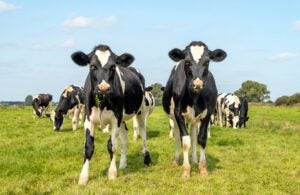The U.S. Environmental Protection Agency has released its 2024 report titled, Inventory of U.S. Greenhouse Gas Emissions and Sinks: 1990-2022. This annual report provides an estimate of all man-made greenhouse gas emission sources in the U.S. and estimates of the amount of carbon trapped in forest and vegetation soil.
The newest report found that between 2021 and 2022, agriculture decreased greenhouse gas emissions (GHG) by almost 2 percent.
Let that sink in. This is the largest decrease amongst all economic sectors in the U.S. This is especially important since overall GHG emissions in the United States increased by 1.3 percent.

In 2022, total emissions from agriculture equaled 634 million metric tons of CO2, which is 9.99 percent of all U.S. emissions. This is a decrease of 1.8 percent from 2021 to 2022. To break ag emissions down even further, in 2022:
- Emissions from crop cultivation totaled 319 million metric tons of CO2, which is just over 5 percent of total emissions and is a decrease of 1.7 percent, from 2021.
- GHG emissions from livestock totaled 4.3 percent of all emissions, which is 274 million metric tons and is down 2.1 percent from 2021.
- Fuel combustion utilized by the agricultural sector contributed 41 million metric tons of CO2, which is only 0.64 percent of total emissions. Fuel combustion emissions decreased 1.2 percent from 2021 to 2022.
The decrease in emissions is due to conservation initiatives, new technologies, and other agricultural advancements. Some practices that helped ag decrease its GHG emissions in one year are reduced or no-tillage, improved manure management practices, and planting cover crops. Conservation initiatives, such as restoring degraded wetlands, also help decrease emissions.
Many of these practices are implemented by farmers voluntarily, as many producers want to be more sustainable and decrease GHG emissions. There are also carbon credit and other market programs that incentivize these initiatives.

To take a deeper look at livestock emissions, the report found that beef cattle contributed a total of 2.19 percent of U.S. GHG emissions, which is a 2.43 percent decrease from 2021. Dairy cattle contributed only 0.77 percent of total emissions. Swine contributed only 0.05 percent of emissions, while sheep and horses each contributed just 0.02 percent of total U.S. emissions.
Some of the decreases in emissions from livestock are due to smaller livestock inventories due to drought conditions in 2022.
There are many other reasons for animal ag’s continued decrease in emissions. Utilizing new technologies, following expert guidelines, and advances in nutrition, genetics, and management practices all contribute to animal agriculture’s decreasing environmental impact.
Animal ag is not new to decreasing GHG emissions. From 1990 to 2022, the dairy industry decreased GHG emissions by 26 percent per billion pounds of milk produced, while increasing milk output by 53 percent. Some of this is due to advancements in genetics, animal nutrition, and management practices, while new technologies like using anaerobic digesters to convert manure into usable energy also play a big role. Similarly, the beef industry has produced 44 percent more beef from 1990 to 2022, while decreasing GHG emissions by 28 percent.

Since 1990, U.S. agricultural emissions have increased by a total of 6.4 percent. At the same time, the U.S. population increased by 33 percent, adding over 83 million people in three decades. American agriculture has risen to this challenge and has greatly increased productivity to feed this increasing population.
Since 1948, agricultural outputs have increased three times per unit of input used. This means that ag is doing a great job of producing more while using the same (or less) inputs. Thanks to advancements in technology, agricultural emissions per capita have declined 20 percent since 1990. When you adjust for productivity gains in ag, the 6.4 percent increase in agricultural emissions drops to a 25 percent decline since 1990. This is a huge success for the ag industry.
The Inventory of U.S. Greenhouse Gas Emissions and Sinks report proves just how important agriculture is to decreasing GHG emissions. The report shows that ag is well on its way to meeting sustainability goals. Agriculture decreased its emissions by almost 2 percent in just one year and by 25 percent since 1990 (when adjusting for productivity gains). These are impressive results and are bigger decreases than other economic sectors in the U.S.
It’s likely that ag will continue to become more sustainable thanks to new research and innovations. Thank you to the people who work hard to provide food, fuel, and fiber more sustainably than ever before.
Michelle Miller, the Farm Babe, is a farmer, public speaker, and writer who has worked for years with row crops, beef cattle, and sheep. She believes education is key in bridging the gap between farmers and consumers.



